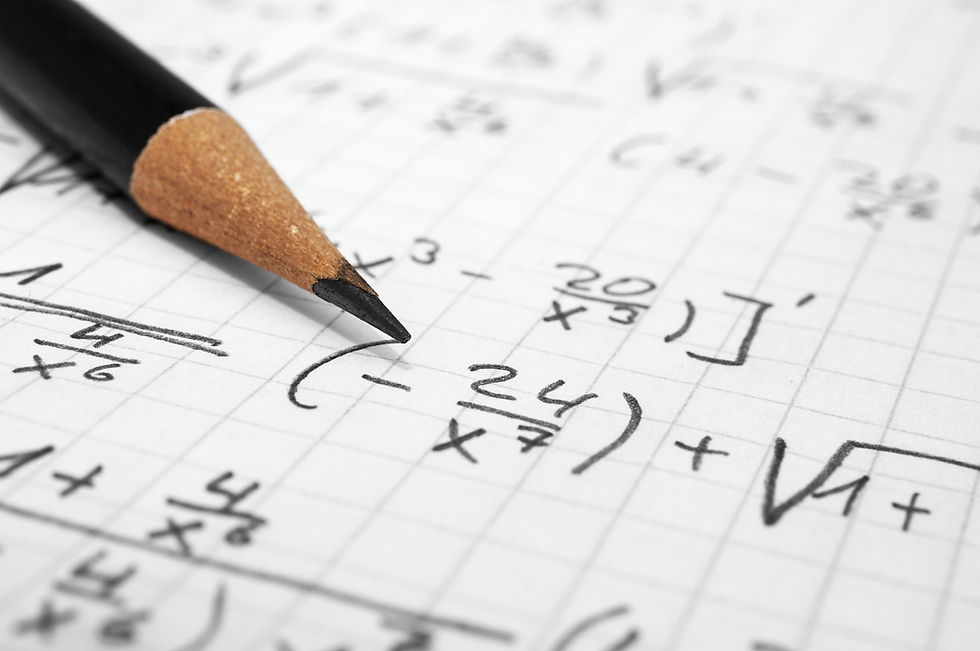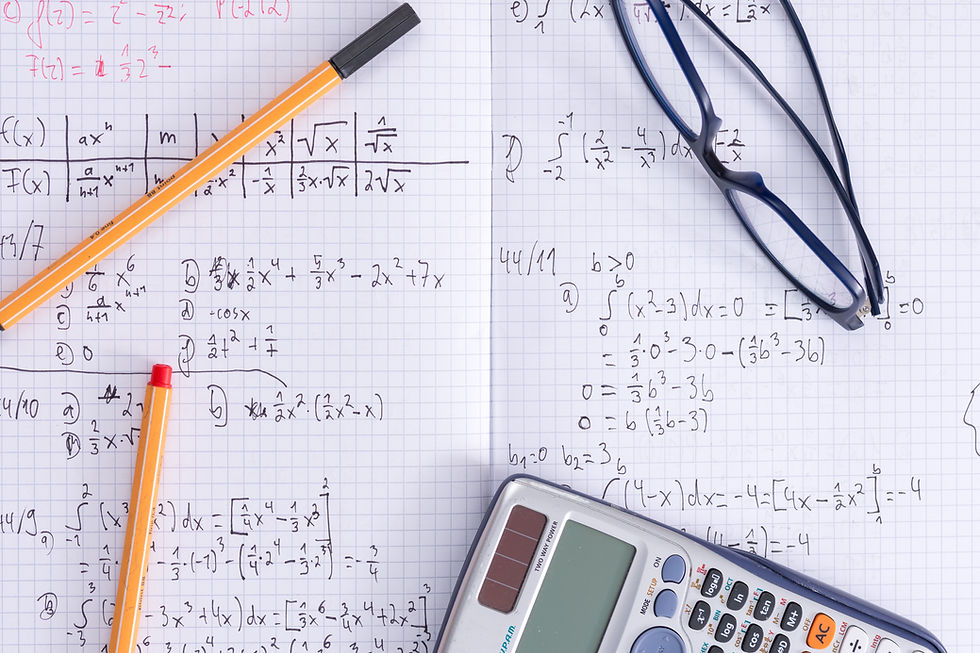Five Ways CAOS Robotics has used Mathematics
- CAOS Robotics
- Aug 8, 2023
- 6 min read
Updated: Oct 24, 2024

By Lucy C.
Data science. Logistics. Information security.
These three careers are among the top twenty occupations projected to grow the fastest, according to the Bureau Labor of Statistics.
What do these careers all have in common?
All three of them require proficiency in mathematics; data scientists have to learn how to utilize statistics to solve problems, logisticians have to apply arithmetic and mathematical modeling to coordinate supply chains, and information security analysts need to analyze systems and algorithms in order to protect sensitive data.
Given that such math-centric careers are projected to grow rapidly, our team is aware of how crucial mathematical knowledge is to the workforce. Having been participants in FTC’s 2022-2023 season, we are more aware than ever that math has played an integral role in the design of the Picky Eater, a robot tasked to intake and plunge cones down plastic poles called junctions.
Below are five math important topics that have been wonderful assets in ensuring our success in completing the design of our robot.
1. Measurement

One of the most basic yet integral math tools we used while designing the Picky Eater was measurement.
While working on our robot, we used a variety of basic measurements to position the robot’s parts and establish ideal dimensions for its hardware.
For instance, according to one of FTC’s guidelines, our robot had to have dimensions no greater than 18 in x 18 in x 18 in; it would literally have to fit in a box with those exact dimensions!
Understanding the importance of meeting this criteria, we used simple measurement to strategically purchase ideal parts; once inspection came, our robot measured to be 15.75 x 15.5 x 18 inches, thereby meeting the design constraint and helping us advance into the competitions!
We also had to make prudent measurement decisions while developing the intake. We knew we had to 3D print an intake that was large enough to extend and engage with the grooves on the edges of the cone, but small enough to actually fit inside the cone. This was why we had to measure the cone’s length and diameter to ensure we were creating accurate dimensions for the intake.
In addition, our mechanical engineers also had to conduct some basic measurements to ensure the battery for the robot’s motor was mounted in an ideal and non distracting position. We obviously needed to ensure the robot had a power source, but we did not want a naked battery to end up taking away from the aesthetics of our robot, so after measuring the battery and the robot, we were eventually able to find a space that was voluminous enough to fit our battery. We then used some of these basic measurements to create patterning on the battery so that it could better blend with the aesthetics of the robot.
2. Trigonometry

Trigonometry… a student’s worst nightmare!
How can playing with triangles and pouring over angle measures be applied in real life?
Throughout this season, trigonometry has been invaluable to the development of both the hardware and software of our robot.
In particular, we extensively utilized the inverses of each of the three trigonometric ratios to translate abstract ratios into practical angle measurements; these angle measurements were used to help position and design our hardware. This was particularly helpful for the design of our intake; while modeling prototypes of our robot’s intake via computer-aided design, we were able to use trigonometric angle measurements to adjust the dimensions of the intake accordingly—that way, the intake could engage with cones easily and at an ideal angle.
Trigonometry was also used for the robot’s localization—this helps the robot calculate its position relative to its environment. Our programmers essentially input distance data into the robot’s code. We translated and visualized this data as triangles, using the side lengths to calculate particular distances and angles that would help the robot understand its position relative to the environment.
3. Calculus

Calculus is “the study of how things change,” according to MIT’s Calculus for Beginners and Artists.
Our robot’s distance and positioning was destined to change throughout its autonomous period. After all, how can our robot make decisions autonomously if it cannot take into account the fluidity of change?
To increase the precision of our robot’s autonomous performance, we decided to use two key concepts in calculus: derivatives and integrals.
Derivatives describe a function’s instantaneous rate of change at a given point. Students can calculate this rate of change by drawing a tangent line through the given point and computing the slope of the tangent, or by by using the slope formula and the basic concept of derivatives.
Finding the rate of change at a given instant is especially useful in a function that is fluctuating and nonlinear. We knew that this would be helpful in our autonomous period, as we could not realistically expect the robot to move at a consistent, linear rate and position during entire competitions. Using derivatives to understand where the robot might be at certain given moments would hence be helpful in amplifying the precision of our robot’s autonomous motions.
Meanwhile, integrals can be used to calculate the area inside a function’s curve. This area would represent the accumulation of something during a given period of time. In this case, distance and motion data would be represented by the calculations we make with integrals. Like derivatives, integrals helped increase the precision of our autonomous period by taking change into account; because the way our robot moved involved fluctuating, nonlinear accumulations of motion data, we knew that incorporating integrals into our autonomous programming would be important to ensuring accuracy in our autonomous code as well.
With the help of the motion planning library Roadrunner, CAOS Robotics was able to use derivatives and integrals to increase the accuracy of our robot’s autonomous performance (learn more about how we used Roadrunner here).
4. Splines

Yes, splines deserve an entire spot on this list! Simply put, spines are what we may call “piecewise polynomial functions.” Essentially, a series of polynomial lines and curves are “pieced” together to create a complex shape—this shape would be approximated by a spline curve.
Splines were used for the robot’s pathing—complex code meant to guide a robot toward an intended path of travel. Because spline curves could be used to represent complex, nonlinear paths of motion, our programmers found them extremely flexible and feasible.
5. Financial literacy

Throughout our 2022-2023 season on FTC, we have been able to manipulate hardware, operate a 3D printer, spread the word about FTC and CAOS Robotics, and more. These are all amazing feats, but none of these would have been done without funding and finances!
Throughout our 2022-2023 season, we have employed three fundamental skills in financial literacy: budgeting, planning, and investing.
First, we needed to arrange a budget based on the rate we predicted we would earn money and the rate we predicted we would spend that money. We decided to utilize Google Sheets in order to better organize our data and formulate a smart budget. For our 2022-2023 budget, we knew that some of our main sources of revenue included family, friends, schools, and local grants and donations; having either known or researched these people and organizations, we were already able to estimate how much money they would be willing to donate to us, creating revenue projections to better prepare for the season.
We then took into account what we would have to spend; based on experiences in our previous seasons, we knew some of the expenses we would have to cover included registration fees, travel expenses, hardware expenses, and ancillary expenses for our branding and marketing. Similar to what we did with our revenue, we used the same Google Spreadsheet to tabulate data about our potential expenses, using our spending history from previous seasons to estimate how much money we would need to use. We then incorporated these totals into our projected expenses.
After that, we used both of these projections to create a “projected budget” to prepare off of before we got too deep into the season.
Second, we knew that both of these projections were destined to change due to factors like inflation, so we had to apply flexible, long-term planning in order to be better prepared to adjust our calculations and act on an actual budget. Knowing that the prices of some of the hardware we tend to purchase have increased each year, we knew we had to take this into account in order to formulate a reliable budget. To adjust to these changes, we created separate columns for our actual revenue and expenses, not just our projected revenue and expenses. This was how we were able to better plan financially on the long-term and become more flexible with our arrangements.
Finally, we had to invest the money we received in revenue in order to better adapt to things like inflation. Simply put, we used the concept of compound interest to invest our money and increase our profits:

Simply put, if we invest P dollars in revenue for a certain amount of time (t), interest would be regularly compounded to our investment, increasing our initial revenue exponentially! Hence, in addition to creating our budget and adjusting to inflation, we had to use the money we already had to prepare financially for the season.
These five math topics have all been integral to helping us brainstorm and strategize the design of our robot throughout our 2022-2023 season on FTC. Our team is proud to show how math can be used in the workforce.
What do you think?
Which do you believe is the most interesting math topic CAOS Robotics has used?
Measurement
Trigonometry
Calculus
Splines


Great work, Lucy! While the math categories used will not change this season, our implementation will. Looking forward to having you right there with us tracking each step and how mathematics make the robot come to life!